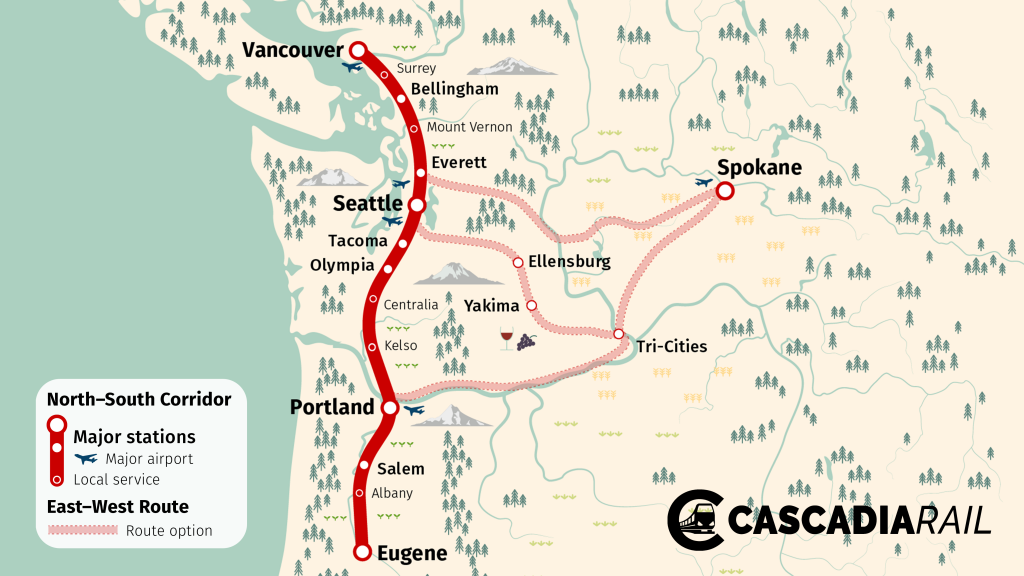Lucid Stew walks us through a “Taking Back The Streets Cascadia Edition” scenario of repurposing I-5 lanes to create a high speed rail line between Eugene and Vancouver, British Columbia, connecting Portland, Tacoma, Seattle, and a handful of other cities along the way. The video is a follow-up from Stew’s earlier video on Cascadia high speed rail, which did not hew exclusively to I-5 right-of-way and included several tunnel sections and fewer stops.
In this sequel, Stew analyzes top speeds and the trip times that would be possible based on the geometry of I-5. High speed trains need very straight tracks to operate at top speeds — 186 miles per hour (or 300 kilometers per hour) for the purpose this analysis — and I-5 isn’t always straight enough to accommodate. Curvy sections would operate at slower speeds.
Nonetheless, a high speed rail line using I-5 freeway right-of-way could still greatly improve travel times along the corridor. Lucid Stew highlights sections where the train can max out its speed, and some segments that are slower and problematic due to the curvy geometry or relatively close stop spacing. In addition to take straight track, it takes some distance to open up to full speed. End to end, the trip would take just over five hours to go from Eugene to downtown Vancouver, British Columbia. Here’s what Stew found for travel times per major segment.
- Eugene to Portland: 1 hour, 7 minutes. 93 mph average, with stops in Albany and Salem.
- Portland to Seattle: 1 hour, 58 minutes, 87 mph average, with stops in Olympia and Tacoma.
- Seattle to Vancouver, BC: 2 hours, 71 mph average, with stops in Everett, Bellingham, and Surrey.
Some tunneling could improve track straightness and thus travel times, but it would also balloon project costs, which are already likely to be considerable. On the other hand, the benefits are also significant as Stew founded tunneling through the problematic sections and dropping a few stops could drop the end-to-end time to three hours and 20 minutes, significantly faster than the five hour time possible with I-5 right of way exclusively and more stops.

The Washington State Department of Transportation continues to study high speed rail with a small planning grant from the Federal Railroad Administration, and hopes of securing a larger grant to advance planning much farther along. Washington State has already been discussing with British Columbia and Oregon how to route the line and structure the cross-jurisdictional entity to make Cascadia high speed rail a reality. Nonetheless, the dream remains many years away.
Polls have found strong public support for high speed rail in the region. The alternative of widening I-5 freeway could be even more costly, while being a less effective transportation solution that is less popular with the public.
Doug Trumm is publisher of The Urbanist. An Urbanist writer since 2015, he dreams of pedestrian streets, bus lanes, and a mass-timber building spree to end our housing crisis. He graduated from the Evans School of Public Policy and Governance at the University of Washington in 2019. He lives in Seattle's Fremont neighborhood and loves to explore the city by foot and by bike.



